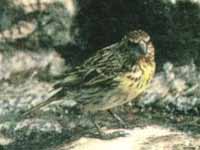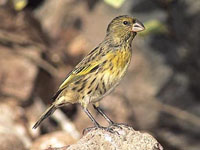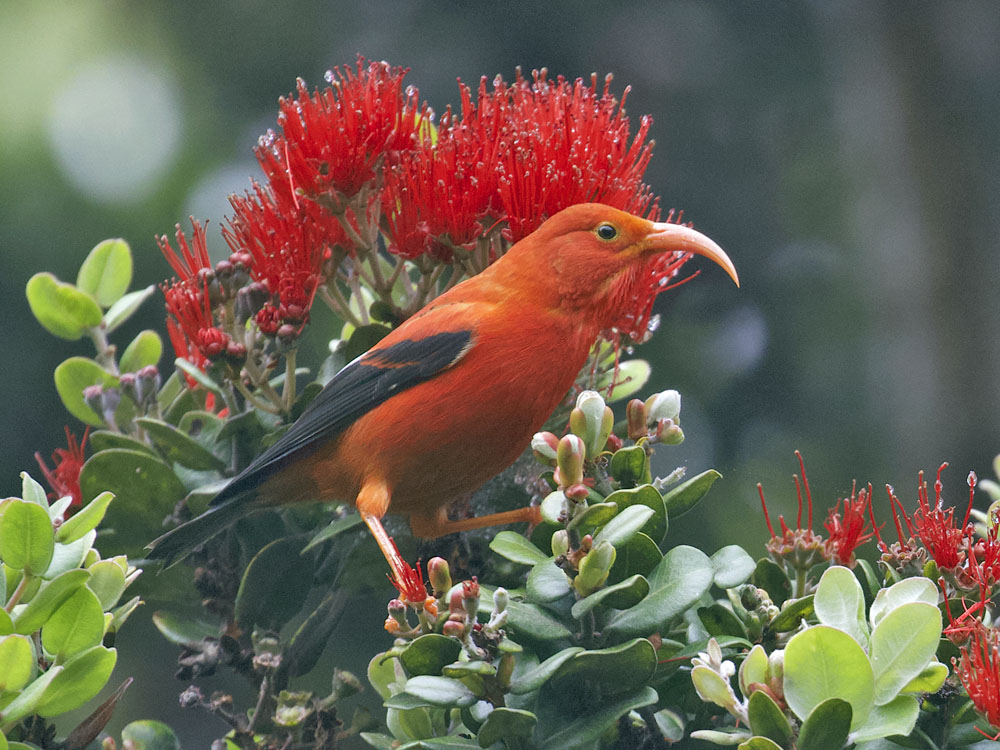THE WORLD BIRDS - An Online Bird Book
Hawaiian Honeycreepers
Order Passeriformes Family Fringillidae
Hawaiian Honeycreepers
Order Passeriformes Family Fringillidae
The Hawaiian honeycreepers are members of the finch family Fringlillidae. Most finches are predominantly seed-eating. Finches typically have strong, stubby beaks, which in some species can be quite large, which enables them to easily crack open seeds. Few of the Hawaiian honeycreepers match the stereotype of a typical finch. The most finch-like are found in genus Telespiza, the Laysan finch and the Nihoa finch. In fact, these are the only members of this finch-subfamily that has finch in their name.
So where did the name "honeycreeper" come from for members of a finch family? Well there is the Hawaiian creeper (Loxops mana) which is so named because it is able walk up and down trees as it probes the bark for insects, This is similar to the behavior for treecreepers of family Certhiidae which are not found on the Hawaiian islands and are extremely distant relatives. Many of the Hawaiian honeycreepers have evolved to have bills and tongues design for obtaining nectar from flowers, hence the name "honey" in their name.
DNA investigations suggest that the Hawaiian honeycreepers diverged around 7 million years ago from rosefinches that are found in Asia. Similar to Darwin's finches of the Galapagos islands, the rosefinches that strayed to the Hawaiian Islands found a variety of habitats and evolved over the millennium to have strikingly different characteristics. The 16 "honeycreepers" belong to 11 different genera which reflects their diversity. Who would have thought that the I'iwi (Drepanis coccinea) which has a long curve bill and can hover like a hummingbird, would be in the same subfamily as th Laysan finch? It took the advent of DNA analysis to make that connection.
Hawaiian honeycreepers are between 10 and 20 cm long. They are diverse in the location of their nests. The majority build their cup-like nests on tree branches, usually relatively high in the tree. Some have their nest in a tree cavity, and the Laysan finch will make it on a bush or on the ground.
The survival of many of these honeycreepers is uncertain usually because of, habitat loss, restricted range, and the introduction of invasive species. One of the most devastating introduced species for Hawaiian birds in general are mosquitos. Just as mosquito borne diseases such as malaria can kill people so can birds be killed by mosquito transmitted diseases. Mosquitos were introduced via shipping to Hawaii in the late 1800's. Since they are non-native, their elimination would not be detrimental to the food supply of any birds. There is general agreement on the islands that the elimination of mosquitos would be beneficial to the environment. One approach to reducing the mosquito population is to release sterile male mosquitos.
Genus Chlorodrepanis
There are currently three amakihi species. Previously all were lumped together as the common amakihi. All three species look quite similar, so the easiest way to tell the difference between them is via location: Hawaii amakihi (Hawaii, Maui, Molokai), Kauai amakihi (Kauai), and Oahu amakihi (Oahu). They all have yellow-green plumage, a down-curved bill, and are about 11 cm long. The amakihi have tongues that can be rolled into a tube shape which they then use to get nectar from flowers and juice from fruits.
Amakihi,_Hawaii Chlorodrepanis virens
Description: The Hawaii amakihi has yellow-green plumage, black lores, a curved black bill, and brown eyes.
Range: The Big Island of Hawaii, Maui, Molokai.
Habitat: Dry or wet forests from sea level to over 2000 meters.
Diet: Nectar, fruit juice, fruit pulp, insects and spiders.
Conservation status: Least Concern.
Image by: 1) Alan_Schmierer - Halealso known asla nat park, Maui 2) USFWS 3) J_Maughn 4) Bettina Arrigoni - Big Island Range: The Big Island of Hawaii, Maui, Molokai.
Habitat: Dry or wet forests from sea level to over 2000 meters.
Diet: Nectar, fruit juice, fruit pulp, insects and spiders.
Conservation status: Least Concern.
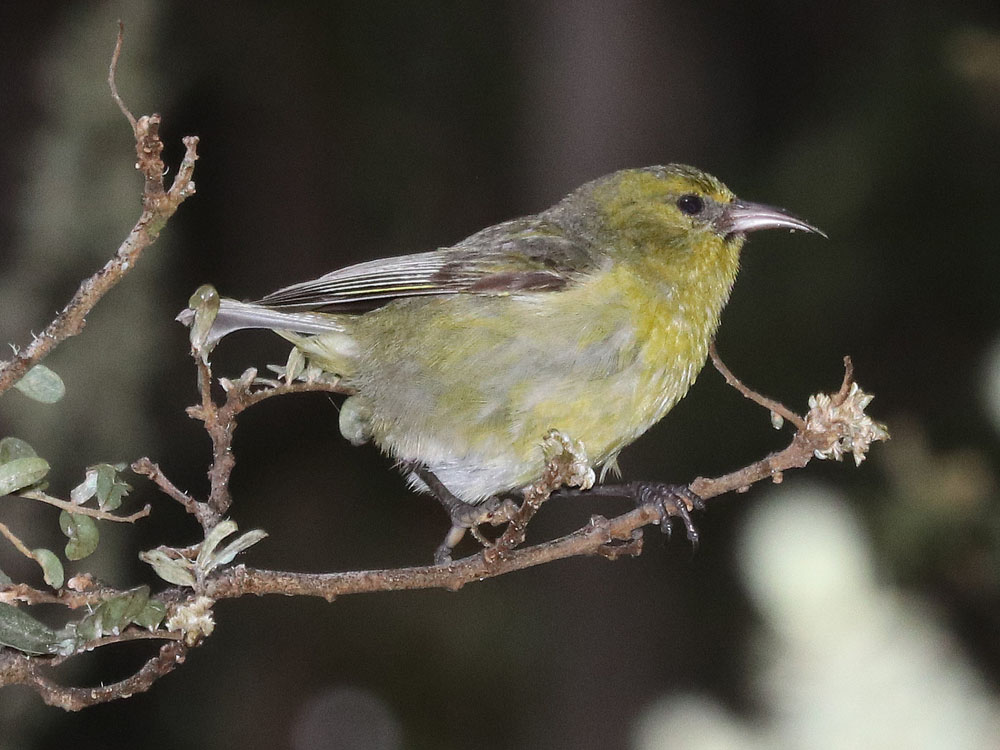
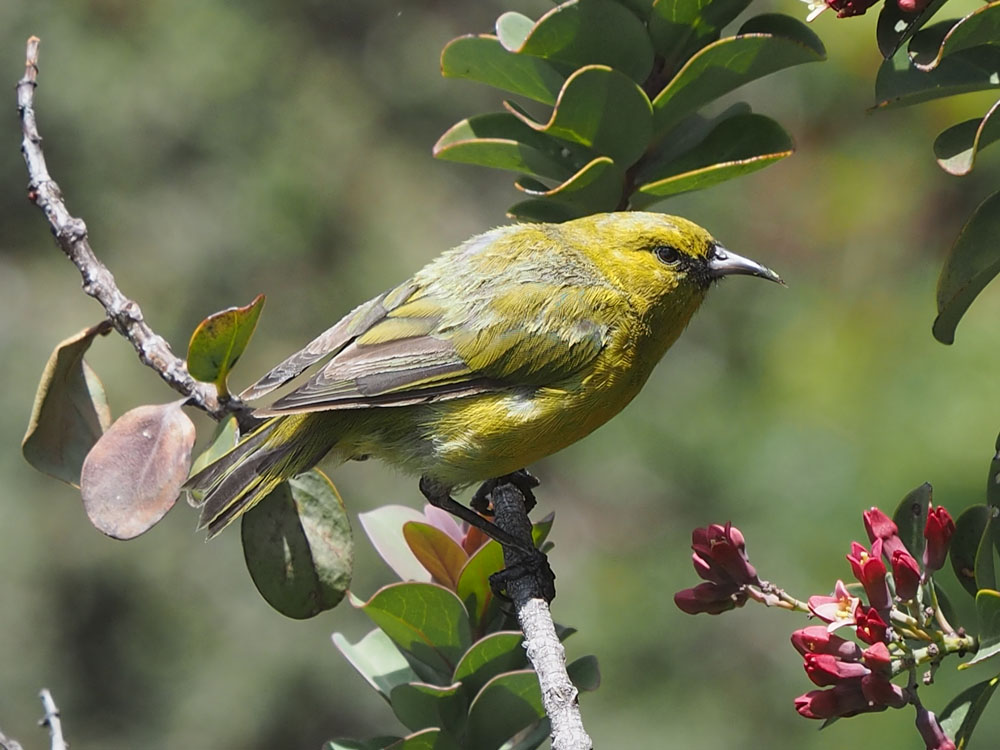

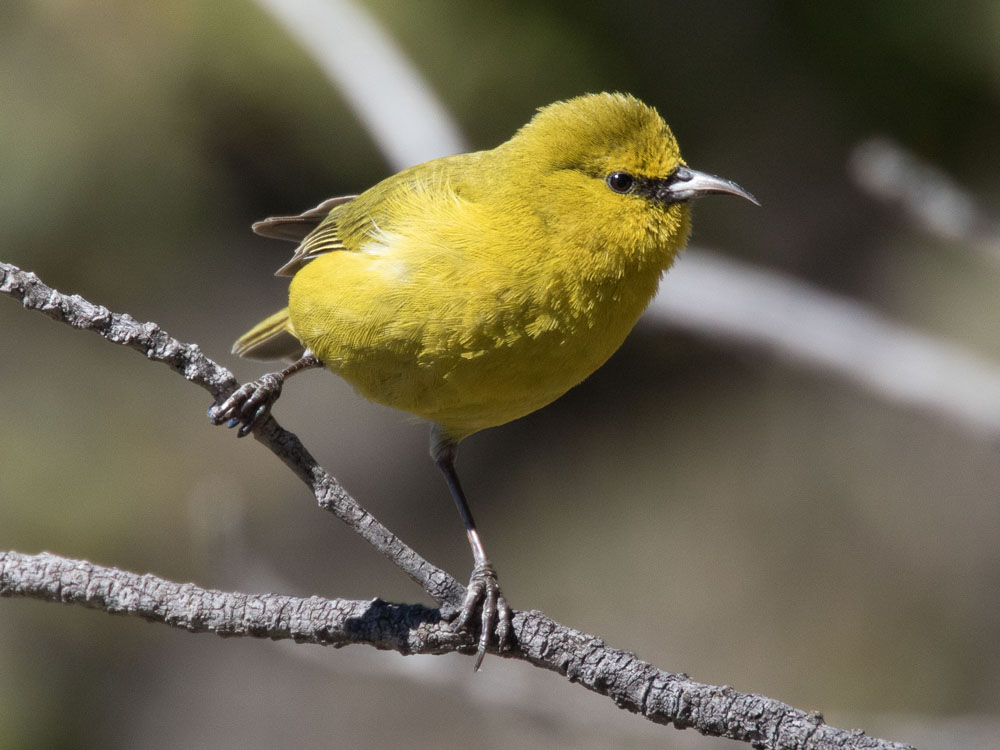
Amakihi,_Kauai Chlorodrepanis stejnegeri
Description: The Kauai amakihi has greenish-yellow plumage, black lores, and a relatively large black down-curved bill. The Kauai amakihi, the largest amakihi, has a longer bill and shorter tail than the other amakihi.
Range: Kauai (Hawaii).
Habitat: Dry or wet forests from sea level to over 2000 meters.
Diet: Mainly insects which it captures for crevices in the bark of a tree. Also nectar and fruits.
Conservation status: It is listed as Vulnerable because of its small range.
Image by: 1) Benjaminkeen 2) Alan_Schmierer 3) Aaron_Maizlish - Waimea, KauaiRange: Kauai (Hawaii).
Habitat: Dry or wet forests from sea level to over 2000 meters.
Diet: Mainly insects which it captures for crevices in the bark of a tree. Also nectar and fruits.
Conservation status: It is listed as Vulnerable because of its small range.
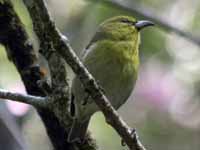
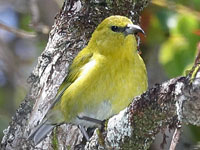
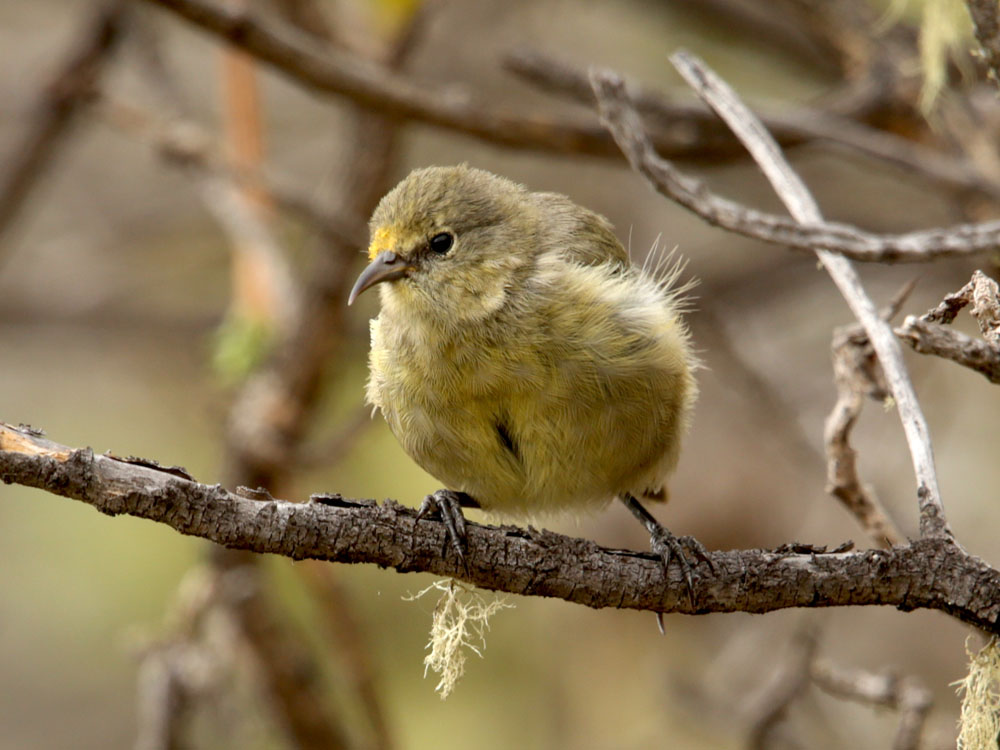
Amakihi,_Oahu Chlorodrepanis flavus
Description: The Oahu amakihi has yellow-green plumage, black lores, a curved black bill, and brown eyes.
Range: Oahu (Hawaii).
Habitat: Southern Oahu that is the wettest part of the island. Usually above 500 m.
Diet: Nectar, fruit juice, fruit pulp, insects and spiders.
Conservation status: It is listed as Vulnerable because of its small range.
Imqge by:
1) Tsuru8 Range: Oahu (Hawaii).
Habitat: Southern Oahu that is the wettest part of the island. Usually above 500 m.
Diet: Nectar, fruit juice, fruit pulp, insects and spiders.
Conservation status: It is listed as Vulnerable because of its small range.
1) Winter plumage
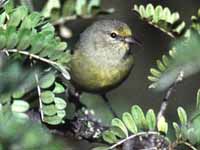
Genus Drepanis - 1 species
I'iwi also Iiwi Drepanis coccinea Found: Hawaii
Description: The I'iwi has mostly scarlet plumage with black wings and tail. It has an orange-red long curved bill used for accessing nectar and yellow-orange feet. It can hover like hummingbirds. The I'iwi is about 15 cm long.
Range: In order of populations, they are found on the Big Island (Hawaii), Maui, and then Kauai.
Habitat: Most abundant in mesic to wet forests at higher elevations. They will migrhate elevation wise following the opening of flowers.
Diet: Mainly nectar. Their favorite source of nectar is from the flowers of the Hawaiian lobelioids. That species is in decline, fortunately the Iiwi also like nectar from ohia lehua tree. They also eat insects and other arthropods.
Conservation status: They are listed as Vulnerable because of declining population from mosquito borne diseases such as avian malaria. Total mosquito elimination on the Hawaiian Islands has been proposed as they are not native and not an essential part of the food chain.
Image by: 1) USFWS 2) Quelle Jeffery- USFWS 3) Jacob Frank - Halealso known asla National Park, Maui 4) Don Metzner Range: In order of populations, they are found on the Big Island (Hawaii), Maui, and then Kauai.
Habitat: Most abundant in mesic to wet forests at higher elevations. They will migrhate elevation wise following the opening of flowers.
Diet: Mainly nectar. Their favorite source of nectar is from the flowers of the Hawaiian lobelioids. That species is in decline, fortunately the Iiwi also like nectar from ohia lehua tree. They also eat insects and other arthropods.
Conservation status: They are listed as Vulnerable because of declining population from mosquito borne diseases such as avian malaria. Total mosquito elimination on the Hawaiian Islands has been proposed as they are not native and not an essential part of the food chain.
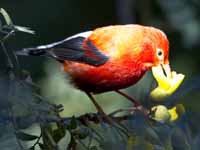
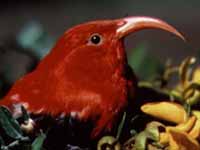
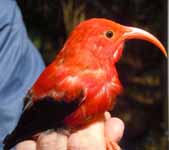
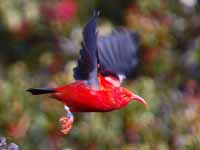
Genus Hemignathus
These Hawaiian Honeycreepers have a mixture of bill size and shapes perhaps indicating the genus should be split. All bills are curved to some extent.
Akiapolaau Hemignathus wilsoni Found: Big Island of Hawaii
Description: The male akiapolaau has yellowish-green upperparts. It has an orange head and underparts, a black bill, black legs, and whitish belly. The upper mandible is longer and more curved than the lower mandible. In addition to the green plumage of the male, the female has a green head and less yellow on the underparts than the male. The akiapolaau is about 14 cm long.
Range: The Big Island of Hawaii.
Habitat: Forests and shrubland.
Diet: Mainly insects; also some tree sap. They find prey in much the same way that a woodpecker does.
Conservation status: It is listed as Endangered. Rats are one of the main reasons their population is under 2000 - rats eat their eggs. Cats and dogs also hunt the birds and their habitat is degrading.
Image by: 1) USFWS 2, 3, 4) Alan_SchmiererRange: The Big Island of Hawaii.
Habitat: Forests and shrubland.
Diet: Mainly insects; also some tree sap. They find prey in much the same way that a woodpecker does.
Conservation status: It is listed as Endangered. Rats are one of the main reasons their population is under 2000 - rats eat their eggs. Cats and dogs also hunt the birds and their habitat is degrading.
1, 2) Female 3, 4) Male
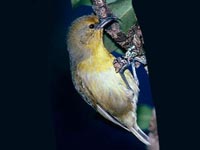
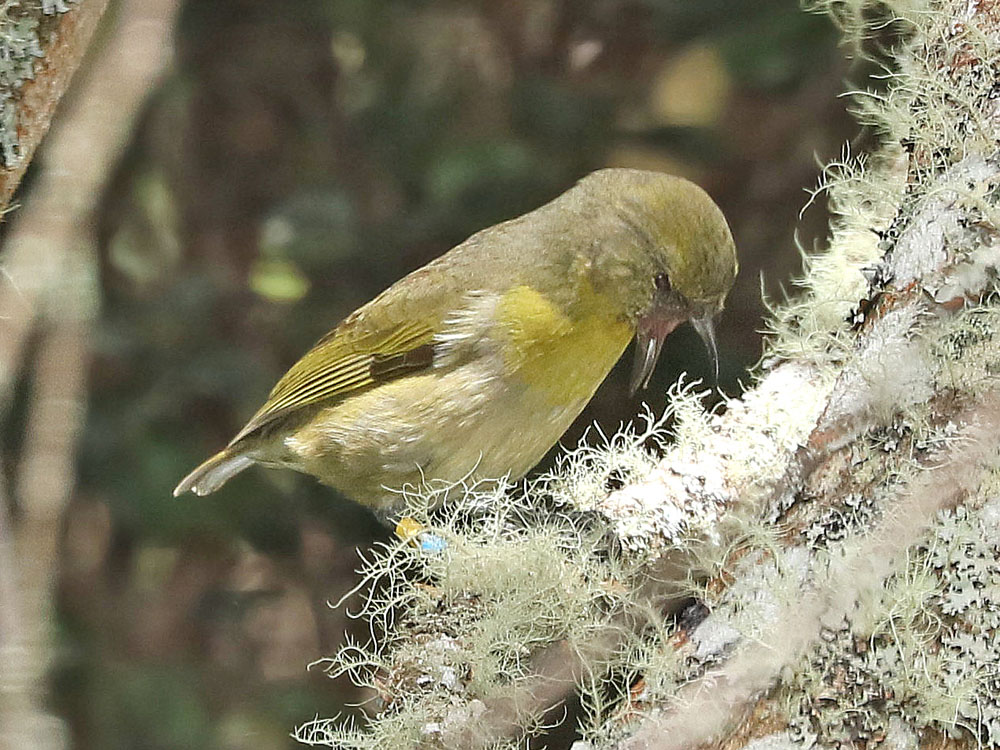
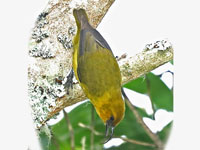
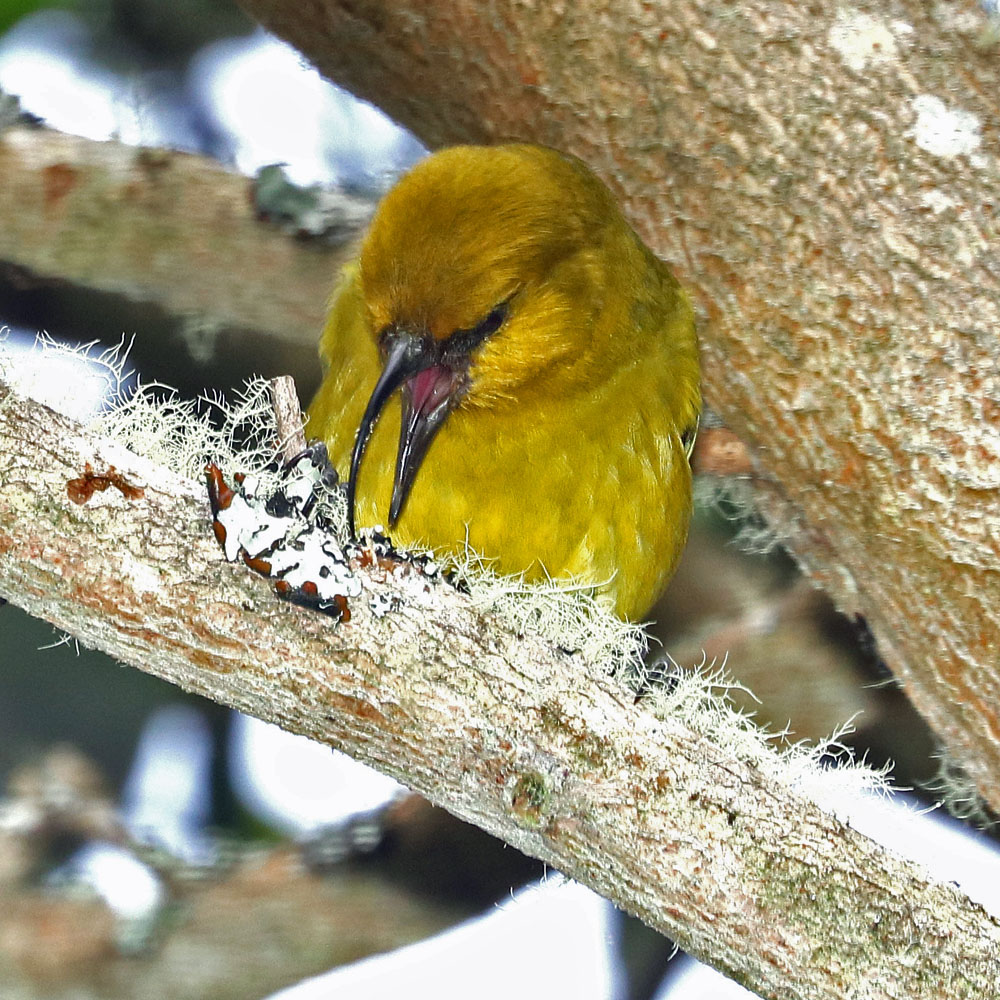
Genus Himatione -1 species
Apapane Himatione sanguinea
Description: The apapane has mainly bright crimson plumage, awhite rump, and a white lower belly. It has black wings, upper-tail, and legs. The black bill is slightly down-curved and they have a brush-tipped tongue that aids in the gathering of nectar. They are often seen with the tail up which displays the white rump. The apapane is about 13 cm long. The nest is usually located on a tree branch, but tree cavities and even a lava cavity have been noted.
Range: All major Hawaiian islands.
Habitat: Usually above 1200 meters where there are fewer mosquitos which give them disease. They vary in elevation in search of Ohia trees that in in bloom.
Diet: Nectar from flowers, especially of the ohia tree. Also insects and spiders which they find on trees, not on the ground.
Conservation status: Least Concern. This is the most common Hawaiian honeycreeper.
Image by: 1) USFWS 2) Mfbrp - Maui 3) Minette_Layne 4) Dick Daniels - MauiRange: All major Hawaiian islands.
Habitat: Usually above 1200 meters where there are fewer mosquitos which give them disease. They vary in elevation in search of Ohia trees that in in bloom.
Diet: Nectar from flowers, especially of the ohia tree. Also insects and spiders which they find on trees, not on the ground.
Conservation status: Least Concern. This is the most common Hawaiian honeycreeper.
1) Juvenile
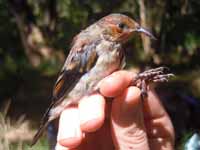
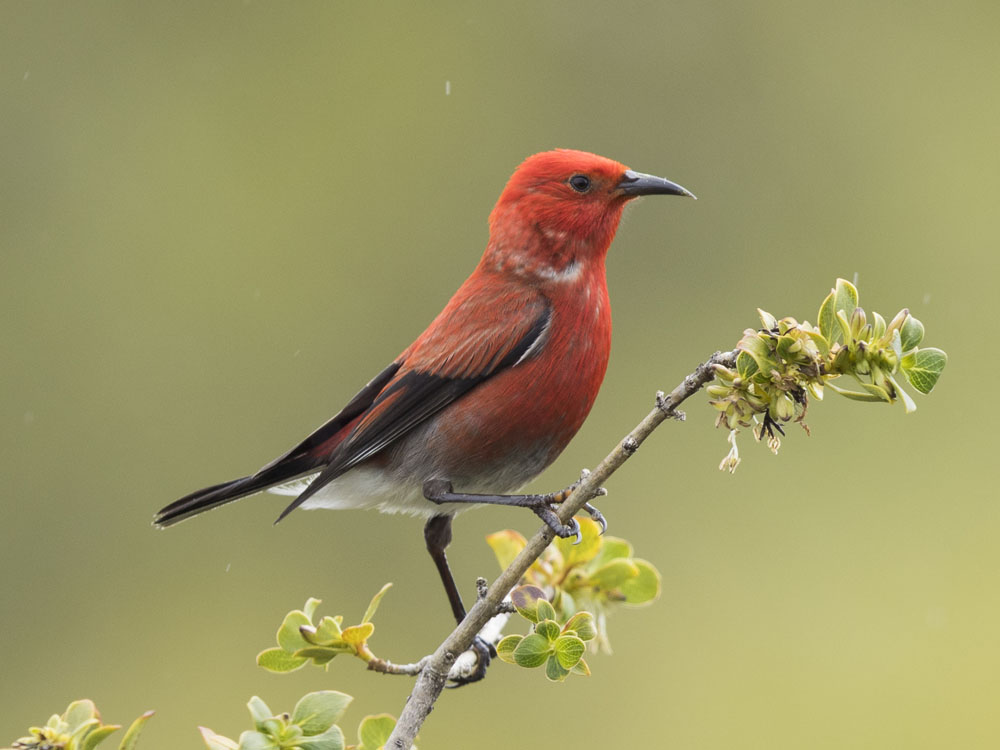
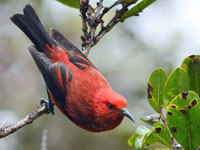

Genus Loxioides - 1 species
Palila Loxioides bailleui
Description: The palila has grey upperparts with golden-green wings and tail. The head and breast are yellow head, the eyes are brown. At up to 19 cm long, this is the largest of the Hawaiian honeycreepers.
Range: Big Island of Hawaii.
Habitat: Dry forests containing; also grassland and shrubland.
Diet: Fruits, seeds, insects, and also leaves.
Conservation status: The palila is listed as Critically Endangered because their natural habit has degraded and now they are restricted to a small area, but that at least is being protected. There is a captive breeding program at the San Deigo Zoo.
Image by: 1) USGS 2) Jack_Jeffrey 3) Caleb Slemmons 4) Aaron_MaizlishRange: Big Island of Hawaii.
Habitat: Dry forests containing; also grassland and shrubland.
Diet: Fruits, seeds, insects, and also leaves.
Conservation status: The palila is listed as Critically Endangered because their natural habit has degraded and now they are restricted to a small area, but that at least is being protected. There is a captive breeding program at the San Deigo Zoo.

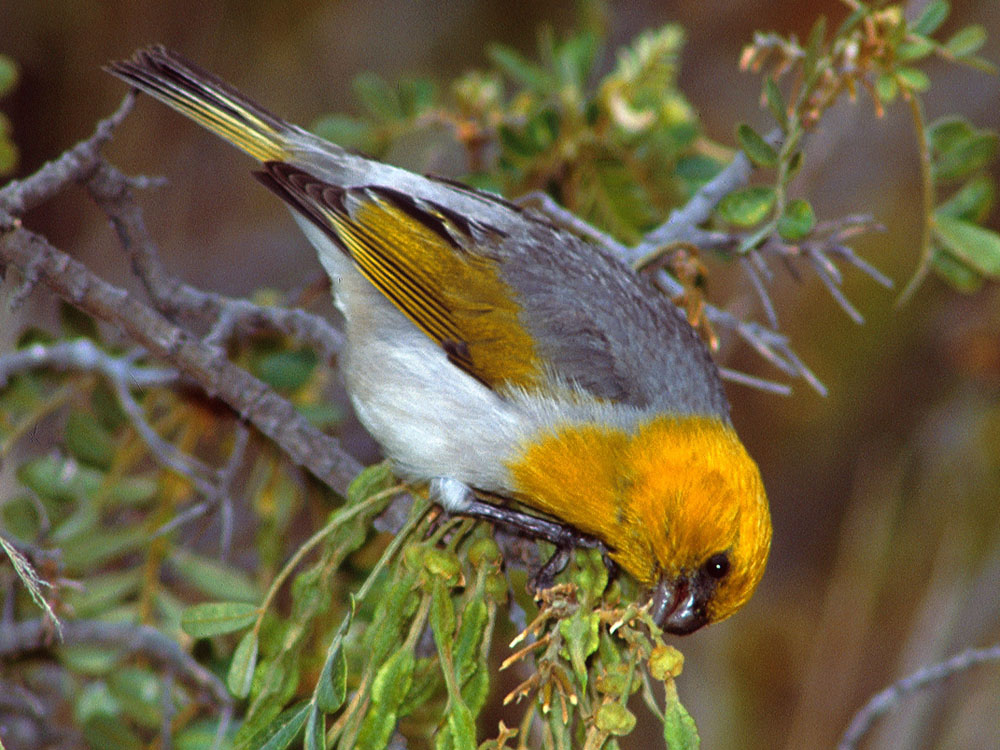
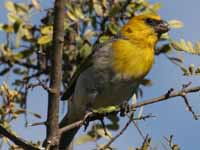
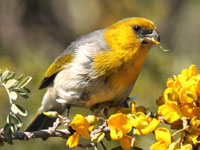
Genus Loxops
Akekee Loxops caeruleirostris
Description: The Akekee has mainly greenish-yellow plumage, a faint black eye-mask, and slightly crossed bill tips. It is about 10 cm long and 11 grams of weight.
Range: Kauai - only in Waimea Canyon State Park, Alakai Wilderness Preserve, and Kokee State Park.
Habitat: Tropical and wet forests.
Diet: Mainly caterpillar larvae, spiders. Also other insects and flower nectar.
Conservation status: It is listed as Critically Endangered because of invasive plants and animals.
Image by: 1) Porter 2) Carter AtkinsonRange: Kauai - only in Waimea Canyon State Park, Alakai Wilderness Preserve, and Kokee State Park.
Habitat: Tropical and wet forests.
Diet: Mainly caterpillar larvae, spiders. Also other insects and flower nectar.
Conservation status: It is listed as Critically Endangered because of invasive plants and animals.
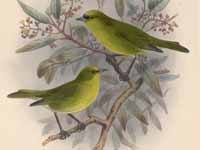

Akepa,_Hawaii Loxops coccineus
Description: The male Hawaii akepa has mainly bright orange plumage. The female has greenish-grey upperparts, lighter grey on the breast. The pale bill is slightly crossed. The Hawaii akepa is about 10 cm long. Unlike most Hawaiian honeycreepers which choose tree branches, the Hawaii akepa predominately locates its nest in a tree cavity.
Range: Hawaii (the Big Island).
Habitat: Forests, disturbed forest with big trees; between 1000 and 2000 meters.
Diet: Spiders, other invertebrates, nectar.
Conservation status: Because of their very restricted area, it is listed as Endangered even though there are about 15000 akepa.
Image by: 1) Aaron_Maizlish 2) Casey_Sanders 3) USFWSRange: Hawaii (the Big Island).
Habitat: Forests, disturbed forest with big trees; between 1000 and 2000 meters.
Diet: Spiders, other invertebrates, nectar.
Conservation status: Because of their very restricted area, it is listed as Endangered even though there are about 15000 akepa.
1) Female 2, 3) Male
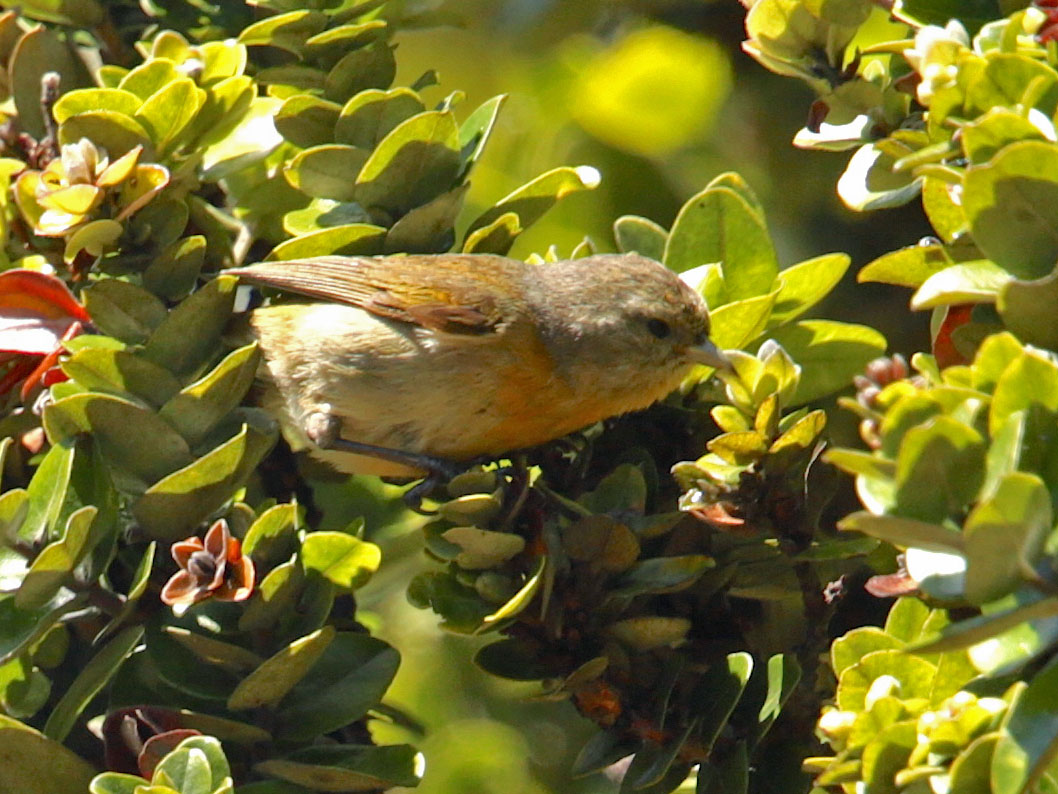
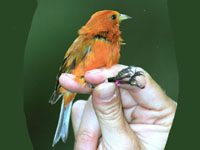
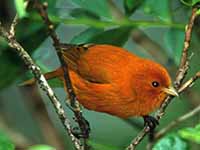
Creeper, Hawaii Loxops mana
Description: The Hawaiian creeper has dull green plumage, paler underparts. It has a pointed grey bill. It usually will create its nest on a tree branch, but sometimes will use a tree cavity. The Hawaiin creeper is about 12 cm long and 14 grams of weight.
Range: Big Island of Hawaii.
Habitat: Forests between 1000 and 2300 meters.
Diet: Mainly insects; also nectar. Similar to a treecreeper, it is able walk up and down trees as it probes the bark for insects.
Conservation status: It is listed as Endangered even though there are about 12000 because of their very restricted area. However, its population appears to be stable.
Image by:
1) Carter Atkinson Range: Big Island of Hawaii.
Habitat: Forests between 1000 and 2300 meters.
Diet: Mainly insects; also nectar. Similar to a treecreeper, it is able walk up and down trees as it probes the bark for insects.
Conservation status: It is listed as Endangered even though there are about 12000 because of their very restricted area. However, its population appears to be stable.
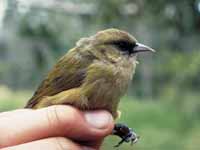
Genus Magumma - 1 species
Anianiau Magumma parva
Description: The male Anianiau has bright yellow plumage, slightly down-curved bill. The female has duller yellow-green plumge. At 10 cm of length, it is one of the smallest Hawaiian honeycreepers. It creates its cup-like nest on a tree branch.
Range: Kauai (Hawaii).
Habitat: Humid forest above 600 m, most often found above 1000 m.
Diet: Mainly nectar. Also arthropods which it captures on trees, shrubs, or vines.
Conservation status: It is listed as Vulnerable as its range on Kauai has been reduced by 85% via invasive species of plants. Rats and mosquito borne avian disease do not seem to be a significant problem.
Image by: 1, 2) Alan_Schmierer Kokee State Park 3) USWGS Range: Kauai (Hawaii).
Habitat: Humid forest above 600 m, most often found above 1000 m.
Diet: Mainly nectar. Also arthropods which it captures on trees, shrubs, or vines.
Conservation status: It is listed as Vulnerable as its range on Kauai has been reduced by 85% via invasive species of plants. Rats and mosquito borne avian disease do not seem to be a significant problem.
1) Female 2, 3) Male
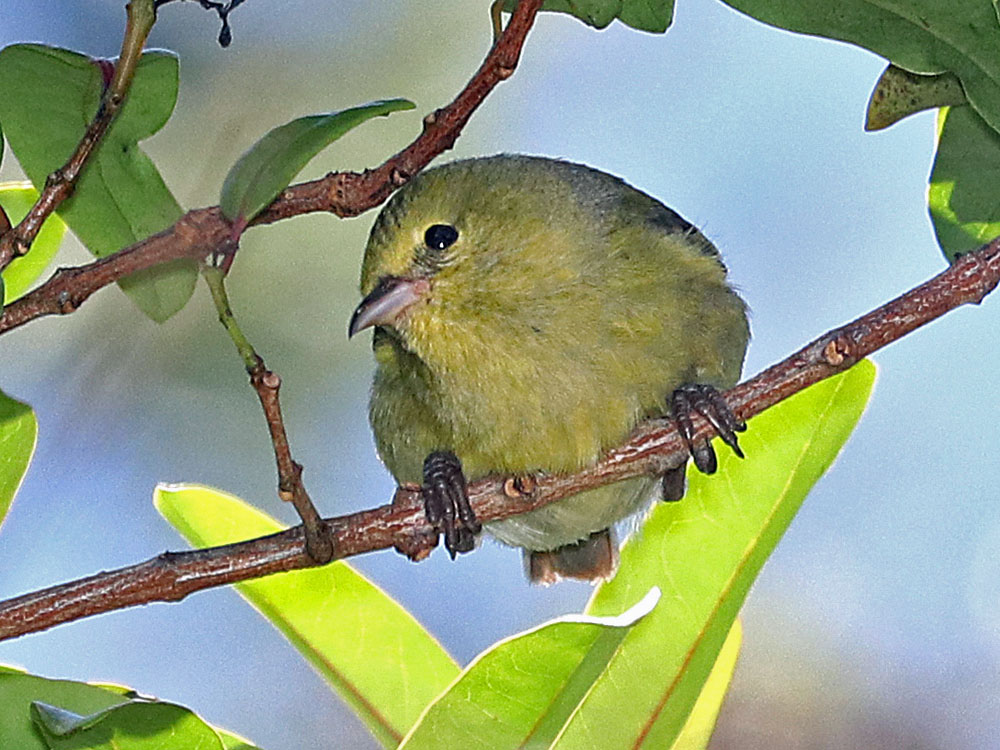
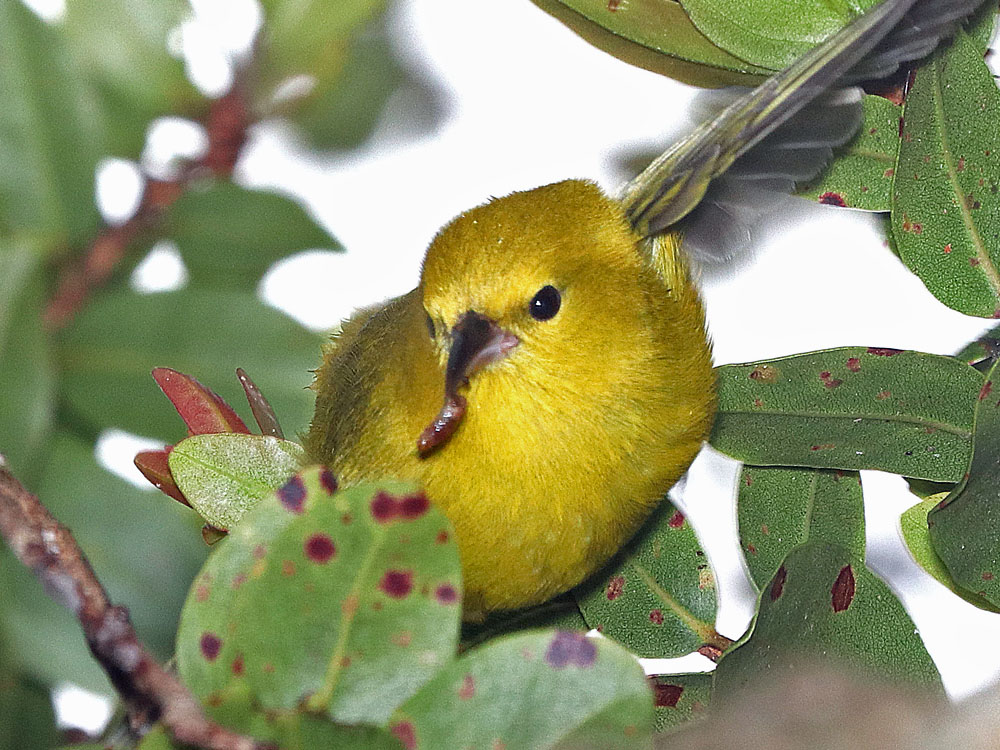

Genus Oreomystis
Akikiki Oreomystis bairdi :
Description: The akikiki has grey upperparts, white underparts, a pink bill, and pink legs. It is about 11 cm long. The tail is short compared to most other birds on Kauai. It creates its cup-like nest on a tree branch. The akikiki is about 12 cm long.
Range: Kauai (Hawaii).
Habitat: High elevations, Now found in just one park and one preserve, it used to be much more widespread, even at sea level.
Diet: Mainly insects which it capture by creeping up and down trees similar to a nuthatch. Also gleans insects from leaves.
Conservation status: It is listed as Critical because the akikiki population and range has substantially declined over the past 30 years.
Image by: 1) Carter AtkinsonRange: Kauai (Hawaii).
Habitat: High elevations, Now found in just one park and one preserve, it used to be much more widespread, even at sea level.
Diet: Mainly insects which it capture by creeping up and down trees similar to a nuthatch. Also gleans insects from leaves.
Conservation status: It is listed as Critical because the akikiki population and range has substantially declined over the past 30 years.
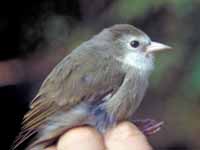
Genus Palmeria - 1 species
Akohekohe Palmeria dolei
Description: The akohekohe, also known as the crested honeycreeper, has glossy black upperparts. The sides are also black and they have whitish stripes. There are some orange tuffs on the head as well as a grey crest. The underparts are black with thin white streaks. It creates its cup-like nest on a tree branch. At 17 to 18 cm long, the akohekohe is the largest honeycreeper on Maui.
Range: Maui (Hawaii).
Habitat: Wet forests on the windward Haleakala from 1300 to 2200 meters.
Diet: The first choice food is nectar. When that is not available then insects and fruit are eaten.
Conservation status: This is a Critically Endangered species because of deforestation and introduced species.
Image by: 1) USGS 2) Kaleomokuokanalu_ChockRange: Maui (Hawaii).
Habitat: Wet forests on the windward Haleakala from 1300 to 2200 meters.
Diet: The first choice food is nectar. When that is not available then insects and fruit are eaten.
Conservation status: This is a Critically Endangered species because of deforestation and introduced species.
2) Specimen
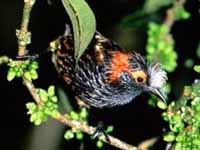
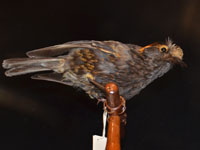
Genus Pseudonestor - 1 species
Parrotbill, Maui Pseudonestor xanthophrys
Description: The Maui parrotbill has olive-green upperparts, crown, and tail. The underparts and supercilium are yellow. It has a dark grey hooked bill, hence the name. They make a cup shaped nest high in a tree. The Maui parrotbill is a large Hawaiian honeycreeper with a length of 14 cm.
Range: Maui in Hawaii.
Habitat: Wet forests with dense undergrowth.
Diet: Mainly insects which it obtains by using its large bill to remove bark to expose them.
Conservation status: It is listed as Critically Endangered because of habitat loss which has resulted in it being found in a very small region. Introduced species such as rats and mosquitos have further decimated the species; and it only has one chick per season.
Image by: 1) Frederick Frohawk 2) Dysmorodrepanis 3) Zach_PezzilloRange: Maui in Hawaii.
Habitat: Wet forests with dense undergrowth.
Diet: Mainly insects which it obtains by using its large bill to remove bark to expose them.
Conservation status: It is listed as Critically Endangered because of habitat loss which has resulted in it being found in a very small region. Introduced species such as rats and mosquitos have further decimated the species; and it only has one chick per season.
2) Juvenile
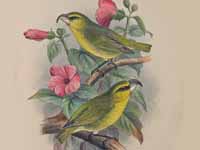
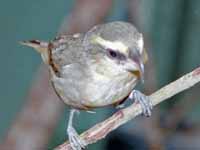

Genus Telespiza
Both Telespiza species are finch-like in appearance. They are found on a few very small Hawaiian islands. Because of limited exposure to humans, they are unafraid and will come right up to people.
Finch, Laysan Telespiza cantans
Description: The Laysan finch has a heavy finch-like bill. The mature adults have a canary like appearance. The male has yellow upperparts including the head. There is a grey neck collar, a yellow breast, and whitish belly. The female is duller than the male and has some brown streaking. The young, especially the females, take a few years to attain their adult plumage and can be substantially brown with heavy streaking. Their cup-shaped nest may be on the ground or in low bushes. The Laysan finch is about 19 cm long.
Range: The Hawaiian island of Laysan and a few other small islands.
Habitat: Sandy scrubland.
Diet: Seeds, small insects, fruit, carrion.
Conservation status: It is listed as Vulnerable due to its restricted range and introduced species. Having the nest on the ground or on low branches makes the eggs and chicks vulnerable to predation. Also, Laysan is mostly below 19 meters of height and the nesting sites are prone to flooding during storms. However, the nesting sites are quite protected from predators now and the population seems to be stable.
Image by:
1) USFWS 2) Allen SmithRange: The Hawaiian island of Laysan and a few other small islands.
Habitat: Sandy scrubland.
Diet: Seeds, small insects, fruit, carrion.
Conservation status: It is listed as Vulnerable due to its restricted range and introduced species. Having the nest on the ground or on low branches makes the eggs and chicks vulnerable to predation. Also, Laysan is mostly below 19 meters of height and the nesting sites are prone to flooding during storms. However, the nesting sites are quite protected from predators now and the population seems to be stable.
1) Juvenile or young female 2) Male
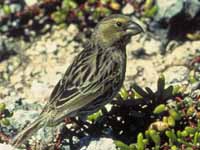

Finch, Nihoa Telespiza ultima
The mature male Nihoa finch has brown streaked upperparts. It has a yellow head, throat, and breast with a white belly. The female has a black back with grey streaks. She has yellowish underparts with some brown, The have a heavy finch-like grey bill. They are smaller than the similar Laysan finch, zbout 17 cm long. Their ranges do not overlap.
Range: Nihoa Island - a tiny Hawaiian Island.
Habitat: Sandy scrubland.
Diet: Indiscriminate in what they eat. In fact, they will eat small pieces of plastic which can be fatal.
Conservation status: It is listed as Vulnerable due to its small range and population. Nihoa does not currently have rats and other invasive species, but their arrival would be devastating. The Nihoa finch's curiosity leads then to fall into water-filled buckets and other containers which can be fatal.
Image by: 1) Stewart Fefe 2) Jack_JeffreyRange: Nihoa Island - a tiny Hawaiian Island.
Habitat: Sandy scrubland.
Diet: Indiscriminate in what they eat. In fact, they will eat small pieces of plastic which can be fatal.
Conservation status: It is listed as Vulnerable due to its small range and population. Nihoa does not currently have rats and other invasive species, but their arrival would be devastating. The Nihoa finch's curiosity leads then to fall into water-filled buckets and other containers which can be fatal.
